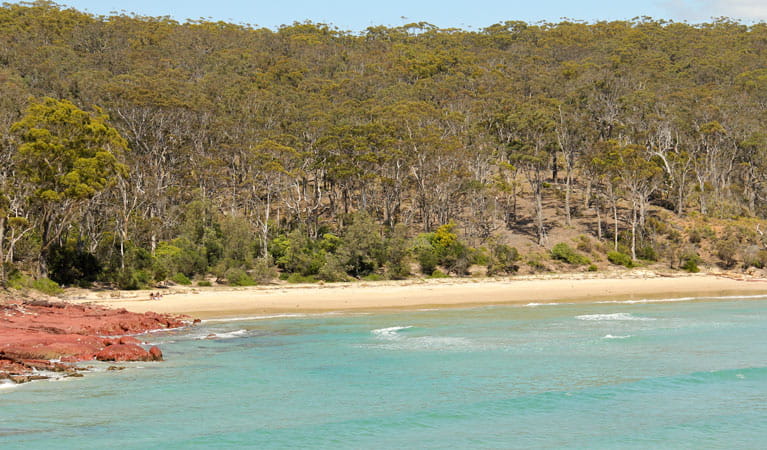Barmouth Beach
Pambula-Haycock area in Beowa National Park
Overview
Barmouth Beach is an easily accessible beach at the Pambula rivermouth, with opportunities for swimming, birdwatching, canoeing, fishing and family picnics.
- Where
- Pambula-Haycock area in Beowa National Park in South Coast
- What to
bring - Drinking water, hat, sunscreen
- Please note
- Remember to take your binoculars if you want to go birdwatching or whale watching
- Strong rips and currents may be present at Barmouth Beach – take care in the water and please supervise children at all times.
- A current NSW recreational fishing licence is required when fishing in all waters. Please note that netting and spear fishing are not permitted in the park, and you’re not allowed to collect crustaceans and marine animals from the rocks.
George Bass first landed at Barmouth Beach on 18 December 1797, seeking shelter from a gale. He travelled up Pambula River and marvelled at the beauty of the place. Since then, thousands of visitors have been inspired by the scenic views, whale watching and birdwatching around picturesque Merimbula Bay, on the spectacular NSW Far South Coast.
Located at the river mouth of Pambula, this family-friendly picnic spot is perfect for a leisurely lunch, with great swimming for the little ones. It’s also ideal for beach fishing, with salmon and tailor in the surf, and bream further up the river. The still water offers great canoeing opportunities and sea kayakers are often seen around the area.
Wildlife abounds in this area, so look for sea eagles, oystercatchers, whales and dolphins. From here, step out along the moderate walking track to Haycock Point.
Map
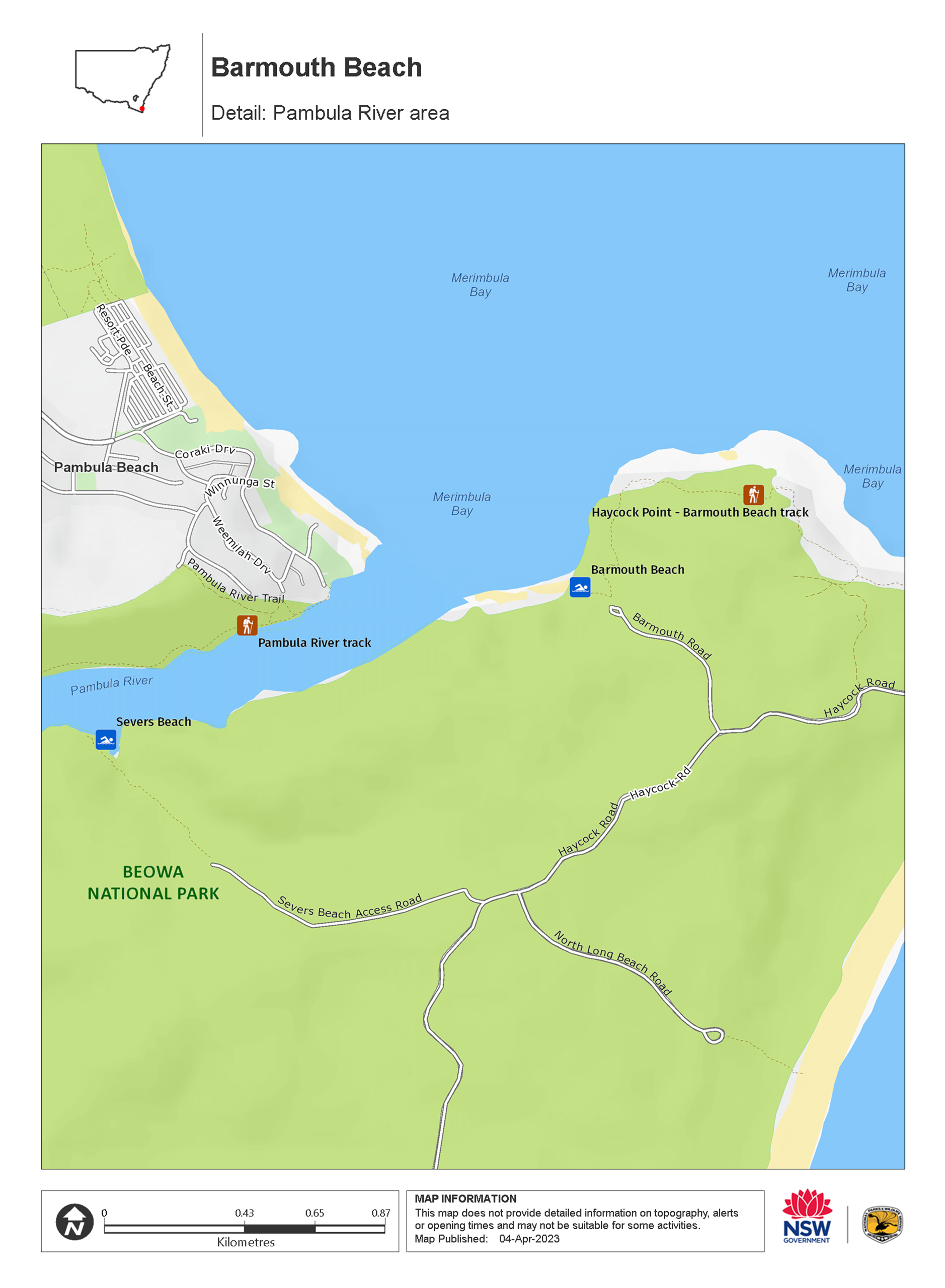
Map legend

Local alerts
For the latest updates on fires, closures and other alerts in this area, see https://www.nationalparks.nsw.gov.au/things-to-do/swimming-spots/barmouth-beach/local-alerts
General enquiries
- National Parks Contact Centre
- 7am to 7pm daily
- 1300 072 757 (13000 PARKS) for the cost of a local call within Australia excluding mobiles
- parks.info@environment.nsw.gov.au
Park info
- in the Pambula-Haycock area of Beowa National Park in the South Coast region
The Pambula-Haycock area of Beowa National Park is always open but may have to close at times due to poor weather or fire danger.
Visitor info
All the practical information you need to know about Barmouth Beach.
Getting there and parking
Get driving directions
Barmouth Beach is in the Haycock Road precinct of Beowa National Park. To get there:
- Follow Princes Highway south of Pambula
- Turn left at Haycock Point Road
- Turn left at the Barmouth Beach access road; you’ll see a sign.
- A short path with steps takes you from the carpark down to the beach
Road quality
- Unsealed roads
Vehicle access
- 2WD vehicles
Weather restrictions
- All weather
Parking
Parking is available at Barmouth Beach.
Best times to visit
There are lots of great things waiting for you in Beowa National Park. Here are some of the highlights.
Autumn
Camp at Bittangabee Beach campground and see lyrebirds performing their characteristic dance and tail display.
Spring
Visit Green Cape Lighthouse or Boyds Tower to spot whales migrating south to their Antarctic feeding grounds - you might even see females with young calves.
Summer
Plan a camping trip to Saltwater Creek - to enjoy the lagoons and beautiful surf beach.
Winter
Take the Light to Light walk when it's nice and cool and the banksias are in bloom.
Facilities
Carpark
Maps and downloads
Permitted
Fishing
A current NSW recreational fishing licence is required when fishing in all waters.
Prohibited
Pets
Pets and domestic animals (other than certified assistance animals) are not permitted. Find out which regional parks allow dog walking and see the pets in parks policy for more information.
Smoking
NSW national parks are no smoking areas.
Learn more
Barmouth Beach is in Pambula-Haycock area. Here are just some of the reasons why this park is special:
Aboriginal culture
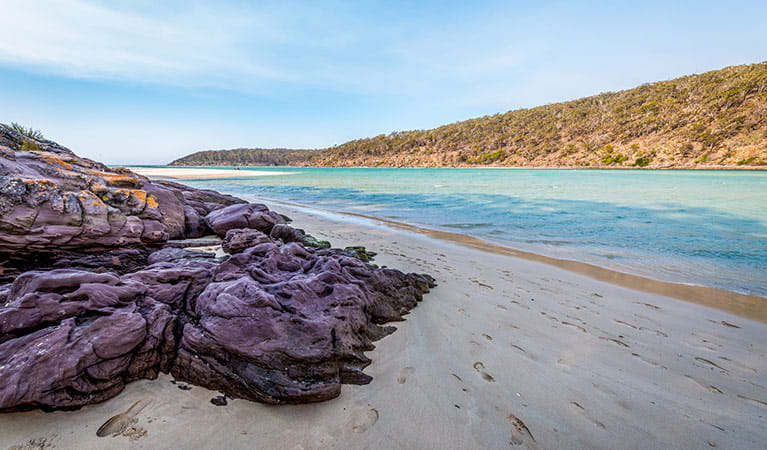
The Yuin People are the Traditional Owners and Custodians of Beowa National Park and they have a long and complex relationship with the coastal environment. Some of the best preserved mounded middens on the east coast of Australia are found in the park along the Pambula River. These middens contain the shells of oysters, mussels and sometimes the bones of sea and land mammals—collected by Aboriginal people from the rock platforms, reefs and estuaries along the park’s coastline.
- Severs Beach Severs Beach, in Beowa National Park in the whale watching town of Eden on NSW’s Sapphire Coast, offers Aboriginal heritage, fishing, beach walks and more.
Rocks tell a story
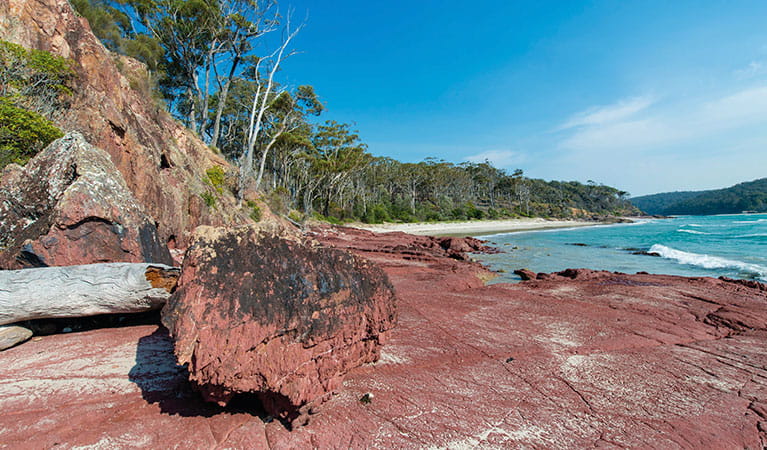
The park’s stunning rock formations, inlets and headlands are the result of extensive geological folding. Most of Beowa National Park lies on red, brown and green shales, sandstones, siltstones and quartzites. These were formed in the Devonian period around 360 million years ago, before dinosaurs roamed the earth. You can see these rock types exposed along the cliffs and headlands. The Devonian period is known as The Age of Fishes and internationally-significant fish fossils have been found in several places along the park’s coastline.
- Haycock Point to Barmouth Beach walking track The walk from Haycock Point to Barmouth Beach in Beowa National Park takes in whale watching, scenic coastal views, wildlife and birdwatching opportunities.
Refuge for threatened species
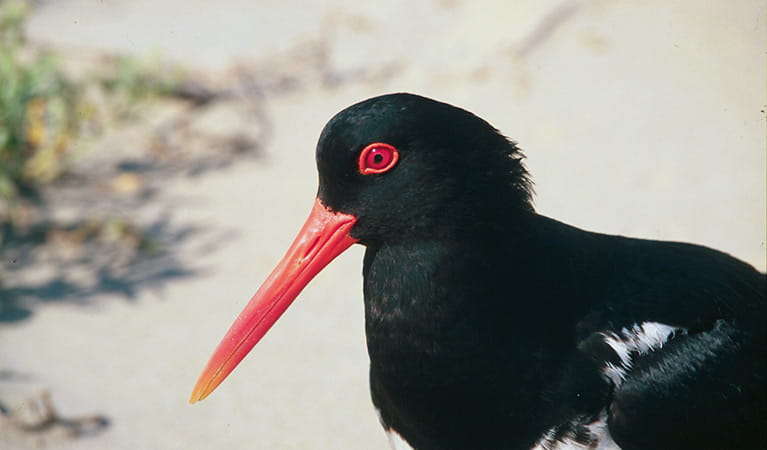
Several threatened species take refuge in the Pambula-Haycock area. North of Pambula River there's an important population of yellow-bellied gliders—listen carefully for their trademark crackles and shrieks. Around 50 native mammals and nearly 150 species of birds have been recorded in Beowa National Park. This includes 1 critically endangered bird, 4 endangered animal species and 25 vulnerable species.
- Haycock Point to Barmouth Beach walking track The walk from Haycock Point to Barmouth Beach in Beowa National Park takes in whale watching, scenic coastal views, wildlife and birdwatching opportunities.
Plants and animals protected in this park
Animals
-
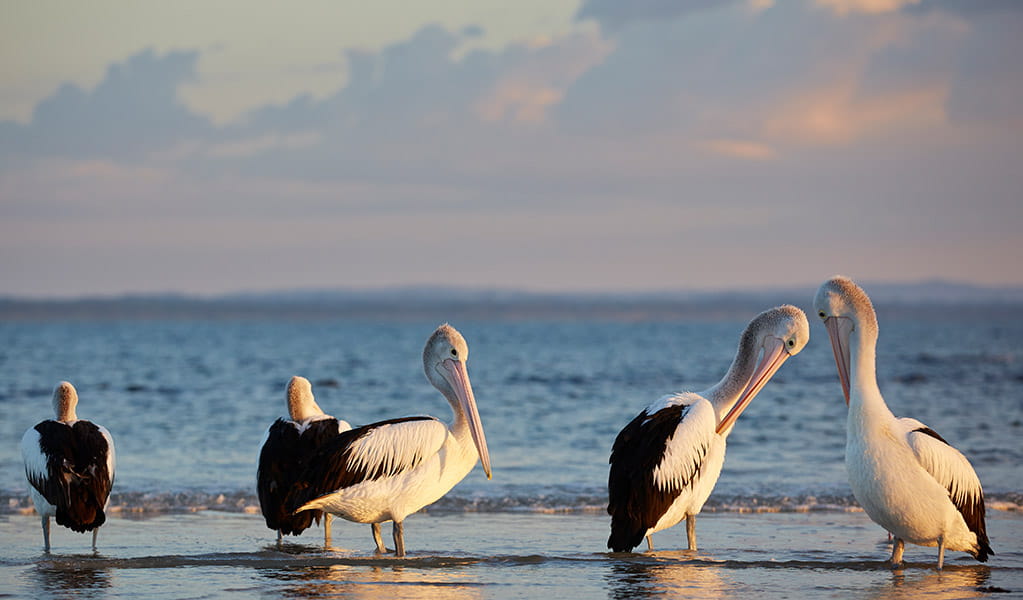
Australian pelican (Pelecanus conspicillatus)
The curious pelican is Australia’s largest flying bird and has the longest bill of any bird in the world. These Australian birds are found throughout Australian waterways and the pelican uses its throat pouch to trawl for fish. Pelicans breed all year round, congregating in large colonies on secluded beaches and islands.
-
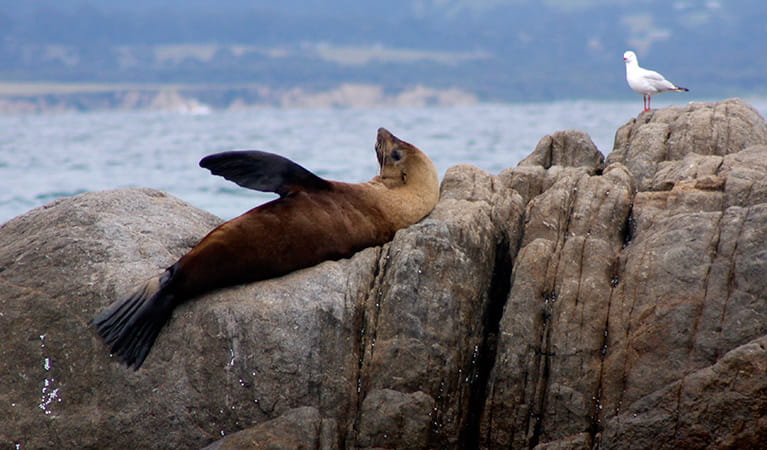
Australian fur seal (Arctocephalus pusillus doriferus)
The largest fur seal, Australian fur seals are found in isolated rocky outcrops and islands along the NSW coast. They come ashore to form breeding colonies and can often be seen at Barunguba Montague Island Nature Reserve.

